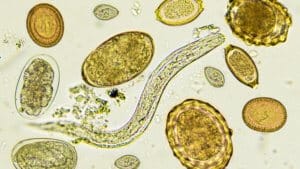Effect of oxalates on your gut microbiota, kidney health and how to eat a low oxalate diet

Effect of oxalates on your gut microbiota, kidney health and how to eat a low oxalate diet
- What are Oxalates?
- How do you know if oxalates are an issue for you?
- Oxalates and kidney stones
- What causes oxalate build up?
- Oxalates and gut health
- How a low oxalate diet help
- How to follow a low oxalate diet plan
- Probiotic and supplements to reduce oxalates
- How we can help
Most healthy people who consume a varied diet don’t need to worry about oxalates or a ‘low oxalate diet’. They’ll consume, on average, 200-300 mg of oxalates per day with no health issues as a result.
But there are two categories of people who do need to be aware of the potential risks of excessive oxalates:
- Those who follow a restricted diet and may therefore eat a larger than average amount of oxalates
- Those who have health conditions that impact their ability to properly handle oxalates that are consumed. 1
A diet high in oxalates can, for some people, have serious implications for their health. With careful attention to diet, often assisted by prescribed probiotics and supplements, oxalate levels can be reduced, and health conditions managed well.

So, what exactly are oxalates?
Oxalate, also known as acid oxalates, oxalic acid or calcium oxalate, is a naturally occurring molecule found in abundance in plants and humans. It is a naturally substance found in many foods.
In plants, oxalate helps to get rid of extra calcium by binding with it. That is why so many high-oxalate foods are from plants.
In humans, oxalates bind to calcium during digestion in the stomach and intestines and leave the body in the stool.
The problem with oxalates is we cannot digest them but if oxalates pass through the GI tract without causing problems, then they aren’t much of an issue.
How do you know if oxalates are an issue for you and whether you need a low oxalate diet?
If you have any of the below health issues, you may have a problem with oxalates:
- fibromyalgia
- migraines
- dizziness
- brain fog
- urinary issues
- joint pain/stiffness
- inflammatory bowel disease and other gut issues
- kidney stones 2
Oxalates and kidney stones
Oxalate that is not bound to calcium travels as a waste product from the blood to the kidneys where it leaves the body in the urine. There are many different types of kidney stones, but eight out of 10 stones are calcium oxalate stones. If there is too much oxalate and too little liquid in the urine, calcium oxalate fragments are created. As the crystals begin to increase in number, they stick to one another to form a larger crystal known as a kidney stone.
Kidney stones are a big concern for those who have or are at risk for kidney disease. The process of stone formation may cause damage to renal tissue, thus decreasing renal function. 3
Those with regular kidney stones have been found to have a higher rate of oxalate absorption. 4

What causes oxalate build up?
- Foods that are high in vitamin C can increase the body’s oxalate levels. Vitamin C converts to oxalate. Levels over 1,000 milligrams (mg) per day have been shown to increase oxalate levels.
- Taking antibiotics, or having a history of digestive disease, can also increase the body’s oxalate levels.
- Those patients with SIBO also often seem to have high oxalate levels.
- Low levels of beneficial gut bacteria or gut dysbiosis.
Oxalates and gut health
The good bacteria in the gut help get rid of oxalate but when the levels of these bacteria are low, higher amounts of oxalate can be absorbed in the body. They pass through the gastrointestinal tract and can contribute to common gut issues such as constipation, gas, bloating and diarrhea.
If you have a gut condition such as leaky gut syndrome or SIBO, your body may absorb more oxalates.
Leaky gut, or increased intestinal permeability, occurs when the tight junctions between the cells that make up the intestinal lining are damaged and become loose. Gaps between the cells allow large particles that should remain in the digestive tract to seep into the bloodstream.
In people with a healthy gut, only a very small amount of the oxalates consumed from food are absorbed into the bloodstream from the gut. However, in people with leaky gut, intestinal dysbiosis (abnormal bacteria in the gut), SIBO or inflammation, the rate of absorption of oxalates might rise from the normal level of 1 to 2 percent to as high as 40 to 50 percent.
In fact, a 2005 study showed there was a link between irritable bowel syndrome (IBS) and the development of kidney stones. The study found that those with kidney stones had a 2.48 times greater chance of later being diagnosed with IBS. 5
How a low oxalate diet help
Healthy eaters, such as those who follow vegan, vegetarian, raw food, Paleo, ketogenic, and other low carb diets often have high oxalate diets so this can be very confusing when those with clean diets experience gut issues similar to those eating junk food.
Vegetarians who consume greater amounts of vegetables will have a higher intake of oxalates, which may reduce calcium availability. This may be an increased risk factor for women, who require greater amounts of calcium in the diet. 6
To lower your risk of kidney stones, add a high-calcium food to a meal that contains a food with higher levels of oxalate. It’s more important to focus on pairing a high-oxalate food with a high-calcium food, and then to look at the nutrients individually.
Some foods will be both moderately high in calcium and high in oxalate, so adding a second source of calcium may be needed.
How to follow a low oxalate diet plan
1. Eat fewer high-oxalate foods
This may be the obvious suggestion. Generally, foods that contain 10 mg or more per serving are considered high oxalate foods. The below foods should be avoided when lowering oxalate intake.
High-oxalate foods include:
- fruits
- vegetables
- nuts
- seeds
- legumes
- grains
High-oxalate fruits include:
- berries
- kiwis
- figs
- purple grapes
Vegetables that contain high levels of oxalate include:
- potatoes
- rhubarb
- leeks
- spinach
- beets
- Swiss chard
To reduce how much oxalate you get, avoid:
- almonds
- cashews
- peanuts
- soy products
Some grain products are also high in oxalate, including:
- bran flakes
- wheat germ
- quinoa
The following foods are also high in oxalates:
- cocoa
- chocolate
- tea
It may seem that many foods contain oxalate, however, this does not mean that everything needs to be avoided. 7
2. Increase the amount of calcium in your diet
Recent research indicates that boosting your intake of calcium-rich foods when you eat foods that are high in oxalate may be a better approach than simply eliminating it from the diet.
As they digest, oxalate and calcium are more likely to bind together before they get to the kidneys, making it less likely that kidney stones will form.
Eat calcium rich foods and beverages every day (2 to 3 servings) from dairy foods.
If you consume dairy, choose high-calcium dairy foods such as milk, yogurt, and cheese.
Vegetables can also provide a good amount of calcium. Choose among the following foods to increase your calcium levels:
- broccoli
- watercress
- kale
Legumes that have a fair amount of calcium include:
- kidney beans
- chickpeas
- baked beans
- navy beans
Fish with high calcium include:
- sardines with bones
- whitebait
- salmon
Meats are safe to eat as they do not contain oxalate. However, eating large portions can increase the risk of kidney stones. Keep proper portion sizes in mind, just 2- 3 servings per day.
3. Limit the vitamin C content of your diet
Oxalate is produced as an end product of Vitamin C (ascorbic acid) metabolism. Large doses of Vitamin C may increase the amount of oxalate in your urine, increasing the risk of kidney stone formation. If you are taking a supplement, do not take more than 500 mg of Vitamin C daily if you are having problems with oxalates..
4. Drink the right amount of fluids every day
Drinking enough fluid each day can help clear kidney stones or even keep them from forming. Spreading your intake of liquids throughout the day is ideal.
It is very important to drink plenty of liquids. Your goal should be 10 – 12 glasses a day. At least 5 – 6 glasses should be water. Choosing water over other drinks is preferable although you may wish to add lemon to your water as research suggests that lemon water may be helpful in reducing the risk of calcium oxalate stone formation.
While lemon water is often touted as a cleansing or alkalizing drink, the main reason it is helpful in reducing stone formation is its citric acid content which inhibits stone formation and breaks up small stones that are beginning to form. 8
5. Eat the right amount of protein daily
Eating large amounts of protein may increase the risk of kidney stone formation. Your daily protein needs can usually be met with 2 – 3 servings a day. Eating more than this if you are at risk at kidney stones is unnecessary.
6. Reduce the amount of sodium in your diet
High-salt diets tend to cause more calcium to be lost in the urine. The more calcium and oxalate in the kidneys, the greater the risk of kidney stones.
Reduce the amount of sodium in your diet to 2-3 grams per day. Limit eating processed foods such as hot dogs, deli meats, sausage, canned products, dry soup mixes, sauerkraut, pickles and various convenience mixes.
Probiotic and supplements to reduce oxalates
Probiotics have been shown to reduce the absorption rate of oxalates by improving gut health. Oxalobacter formigenes and Lactobacillus species may help to degrade oxalates in the gut.
Vitamin B6 and citrates such as calcium, magnesium, and potassium are also helpful. 9

How we can help
In conjunction with your kidney specialist, renal specialise or nephrologist, our practitioners at Advanced Functional Medicine can help you to reduce your oxalate levels naturally to assist in avoiding kidney stones and other related health issues.
Oxalates can be causing a range of issues other than just kidney stones. joint pain. poor absorption and other issues can be common side effects. We commonly run organic acids tests that have markers showing patients oxalate levels along with many other metabolic markers.
Having high oxalates in your body doesn’t mean you have to avoid them entirely, following a lower oxalate diet while addressing underlying causes such as gut dysbiosis and SIBO will allow your body to balance and likely be able to eat foods again without worrying about oxalates.
Call us or fill out the form below to find out more




